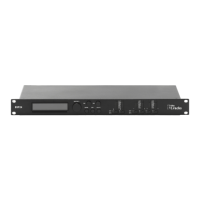19
In order to select the lters type, it is necessary to have the
lters GAIN=0.0dB, then using the PM2 encoder, rotate it
“clockwise” in order to decide the bell lters bandwidth, or
“counter-clockwise” to select the shelving lter type (low or
high) and its order (1
st
or 2
nd
).
So, in order to dene the lter type for the lter number 1
(“x”=1), it is necessary from the above screen, to enter the
lters editing page pressing the ENTER button, and the screen
has to appear as follows:
In this case, the lters GAIN=0.0dB, and being BW=1.05, the
current lter selected is a bell type. Now, rotating the PM2
encoder clockwise, the parameter BW will range from 0.05 up
to 3 for identifying a bandwidth value for a bell lter.
If a bell lter is selected, then the gain can be modied from
0.0dB and the BW will range between 0.05 and 3.
If the user wants to select a shelving lter from the above
setting, with the GAIN=0.0dB [if the GAIN is not 0.0dB, it is
necessary to set it to 0.0dB using the PM3 encoder], rotate
the PM2 counter-clockwise. Once BW reaches the 0.05 value,
at the next step of the PM2 counter-clockwise rotation, the
selection of the shelving lters will be entered.
Still rotating the PM2 counter-clockwise, the shelving lters
and their order will be selectable in the following sequence:
1. 1
st
order low shelving = –6LoSh [on the screen]
2. 2
nd
order low shelving = –12LoSh [on the screen]
3. 1
st
order high shelving = –6HiSh [on the screen]
4. 2
nd
order high shelving = –12HiSh [on the screen]
Once the desired shelving lter is selected, the PM3 can then
be used to select the desired GAIN and when the GAIN is set
at a value different from 0.0dB, then the lter type cannot be
changed until this GAIN is returned to 0.0dB.
BELL lter: As an example, if you want to set a bell lter within
EQ-1, then the BW has to be set at a desired value of say
1.00 using the PM2 encoder, the GAIN at say +3dB using the
PM3 encoder and the centre frequency at say 1.00KHz with
the NAV/PM1 encoder. The EQ sub-menu screen will show the
following:
Once in the bell lters edit screen all the lter parameters can be
modied using the “NAV/PM1”, “PM2”, and “PM3” encoders for
editing the lters centre frequency, bandwidth (BW) and gain.
The centre frequency of the parametric lter can be edited using
the “NAV/PM1” encoder, the BW by using the “PM2” encoder
and the gain by using the “PM3” encoder:
“Centre frequency”: the selectable frequency range is from
20Hz to 20kHz in steps of 1/24 of an octave and can be adjusted
by rotating the “NAV/PM1” encoder.
“Bandwidth BW”: the selectable BW range is from 0.05 octave
to 3 octaves in steps of 0.05 octave and can be adjusted by
rotating the “PM2” encoder.
“Gain”: the selectable gain range is from -15dB to +15dB in
steps of 0.5 dB and can be adjusted by rotating the “PM3”
encoder.
Low shelving lter: As an example if you want to set a low
shelving lter within EQ-1 then the PM2 encoder has to be
rotated counter-clockwise until the desired low shelving lter
say -6LoSh appears on the screen, the GAIN at say +3.0dB
using the PM3 encoder and the high cut frequency at say
1.00KHz with the NAV/PM1 encoder.

